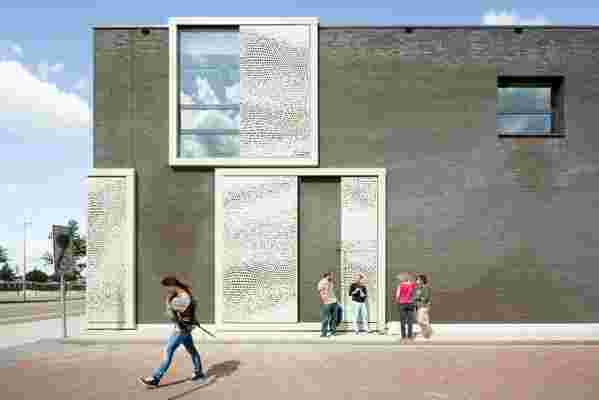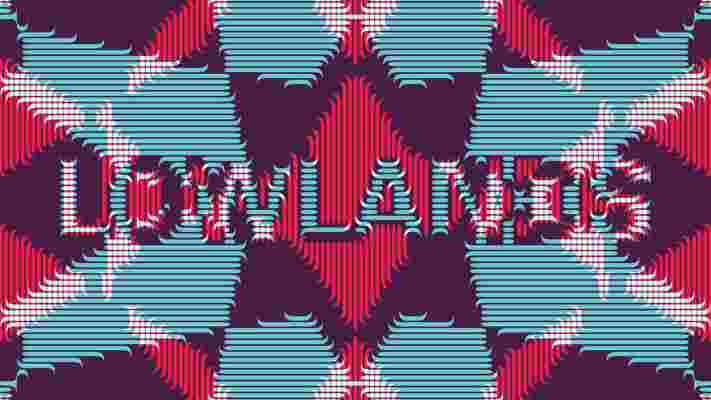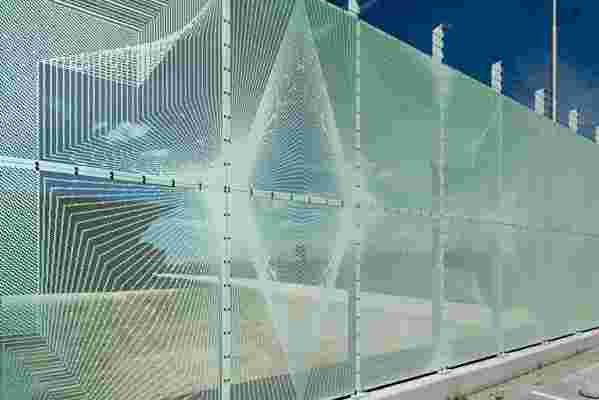“OK, now this is the real thing,” graphic illustrator and typographer Hansje van Halem recalls thinking when she saw the result of her first architectural project—16 perforated steel sliding sun screens designed for De Heldring, a special education school in Amsterdam.
Working with Berger Barnett Architects, she created the façade screens’ striking designs based on wind flow, staying within tight technical limitations to preserve the integrity of the material and the allowance of daylight.
“I really, really liked the materialization of the design,” says van Halem of the project. “Printed matter suddenly felt like a sketch compared to something so large and made to last so many years.”

Van Halem's perforated sun screens adorn the façade of De Heldring, a special education school in Amsterdam.
While the materials and scale were new to her, developing intricate, mesmerizing patterns is van Halem’s calling card. So it seems a natural progression that the Amsterdam-based designer has found herself fielding more and more requests from developers and architects wanting to apply her wizardry to building features.
After graduating from Gerrit Rietveld Academy in 2003, van Halem went to work designing books and reports, while her personal sketchbook became her passion. It grew thick with drawings of letters and patterns, which she first published in endpapers. Soon, book publishers were asking specifically for her endpapers, and then clients came to her solely for her idiosyncratic patterns, with repetitive layers and barely recognizable lettering bordering on the psychedelic. Her posters and monographs have been shown in exhibits and collected by museums.
The designer’s trippiest work is likely the full complement of images she creates for Lowlands, a Dutch music festival, where she’s been head designer since 2017. She works with coders and animators to produce the event’s hallucinogenic body of work.

An example of van Halem's printed graphic design work for Lowlands, a Dutch music festival.
Van Halem, a frequent speaker on the graphic design circuit, also made a recent splash with “Wind,” an optical-illusion typeface with layers that can be overlaid to create hypnotic patterns and with variable fonts capable of a 360-degree rotation.
Van Halem’s most recently completed architectural projects include a 190-foot-long perforated steel screen fence at Amsterdam's Schiphol Airport, which floridly spells out “SmartGate” within a decorative pattern, and a nearly quarter-mile-long (1,148 feet) text monument to honor a historic Jewish area of Amsterdam. The latter, which runs along Tugelaweg, a residential street on the east of the city, relies on laser-cut reliefs resembling balusters to spell out a poem by K. Michel. The words unfurl elegantly alongside a weathering steel retaining wall next to a walking path.

A section of van Halem’s 190-foot-long perforated steel screen fence at Schiphol Airport.
A text monument which honors a historic Jewish area of Amsterdam.
She also has designed a swirling-tile pattern for a portion of the nave at Bonifatius Church in Zaandam, Netherlands; a decorative pattern of bricks along a pedestrian and driveway roadway at Pieter Baan Center, a psychiatric facility in Utrecht, Netherlands; and is working toward a final design for an exterior door as part of an addition to the historic Lakenhal ("Cloth Hall") in Leiden, Netherlands, using repetitive shapes stamped in embossed steel.
Comparing the creative processes of her graphic and architectural projects, van Halem says the origins aren’t so different.
The designer's tile-floor design for Bonifatius Church in Zaandam.
“If you look in my computer files, you’ll find many similarities in how things are working, but the technical material makes it completely different,” she says. “My patterns aren’t so much about drawing or an impression but about making a line and calculating it into 100 lines or making them thicker. I start with an element and have it grow in a certain way. It’s all based on a technical curiosity. At the end I have almost a recipe, and then I can rebuild the system.”
Van Halem’s current architecture project, still in the design phase, is her most ambitious, as she designs motifs in the main entryways of two four-story affordable housing developments by housing corporation Ymere in Amsterdam. Tasked with the goal of giving residents “the feeling of coming home” before entering their own apartments, she took inspiration from 20th-century Amsterdam rowhouses with stoops adorned with tiles, akin to ceramic doormats and wallpaper. Her vision calls for vibrant tile patterns in the entryway and perhaps beyond to mimic that mood.
Van Halem in her studio.
However van Halem designs it, she expects the unexpected when translating her ideas from paper and computer to buildings.
“What’s super interesting to me is that, because I’m working with different materials and the scale is larger, the outcome always feels surprising.”
RELATED: Inside the Growing Nexus of Politics and Design
